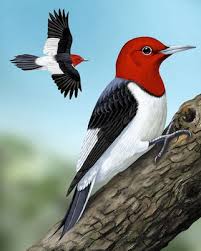 Enjoying the cool of the morning on my screened porch last weekend, I saw a flash of red out of the corner of my eye. This isn’t unusual. I have several red flowerpots on the porch. A red water bucket for the dog. A red flyswatter. Red hummingbird feeders hanging near the walkway. Red verbena in the planter box.
Enjoying the cool of the morning on my screened porch last weekend, I saw a flash of red out of the corner of my eye. This isn’t unusual. I have several red flowerpots on the porch. A red water bucket for the dog. A red flyswatter. Red hummingbird feeders hanging near the walkway. Red verbena in the planter box.
But those things don’t move. This flash of red was on a bird! A very special bird. A bird I’d spotted in my backyard a couple of times in May and hadn’t seen since. Not a cardinal or a red-bellied woodpecker or even a pileated woodpecker. I see those birds all the time.
This was, without a doubt, a red-headed woodpecker.
For those who need it, here’s a quick lesson about woodpeckers. There are many varieties in the United States, including three I see frequently on my feeders. The first is the downy woodpecker, the smallest woodpecker in North America at about six inches long. Its face and wings are black-and-white stripes and its belly is white. Males have a little patch of red on the back of the head. Downy woodpeckers are adorable.
Almost as frequent a visitor are red-bellied woodpeckers, which are bigger (about the size of a blue jay) and have a wide strip of red running from the base of the beak over the rounded head (no crest) and down the neck a little ways. These birds have white faces and white bellies with a slight red tinge to the feathers. Their wings are dense black-and-white stripes.
Last but not least of the commonly-seen-around-here woodpeckers are pileated woodpeckers, sometimes called Good Lord Birds, because folks often say “Good Lord, did you see that bird?” when spotting one. These are “Woody Woodpeckers,” big as a crow and almost as noisy. Their necks are long and elegant. A triangular-shaped bright-red crest sweeps across the back of their black-and-white striped heads. Their chisel-like beaks are long and powerful. Pileated woodpeckers have black bodies with white underwings.
But as exciting as it is to see pileateds, it can’t hold a candle to the thrill of spotting a genuine red-headed woodpecker. They’re sometimes labeled “spark birds” because they’re so beautiful and so unusual that they often spark an interest in birdwatching in folks who were never interested before. Red-headed woodpeckers are about the size of a robin. The head is entirely crimson and has no crest. Their bodies are snow-white and their wings half-white and half-inky black.
Once widespread in many parts of the United States, the species is now classified as near-threatened. The population has declined in part because of the loss of potential nesting sites. Red-headed woodpeckers like to drill nesting cavities in dead tree trunks or branches. These days, dead trees are harder to find because they’re often hauled off or burned to keep things “neat.” The introduction of European starlings, which are also cavity-nesters but which can’t drill their own holes, has hurt red-headed woodpeckers, too, because starlings steal their nesting sites. So has the loss of old-growth beech trees, which provide one of the red-headed woodpeckers’ favorite foods.
Luckily, they’re one of the most omnivorous of the woodpecker species. Red-headed woodpeckers feast on insects, spiders, earthworms, wild and cultivated fruit, seeds, corn, acorns and—occasionally—small rodents. My back yard has plenty of all of those things, in addition to a couple of pretty impressive dead trees.
I refuse to have those trees removed. I’m keeping my fingers crossed that, when they finally do topple, they won’t hit the house. And I’m keeping my fingers double-crossed that the red-headed woodpeckers who’ve found them have told all their friends that my yard is the perfect place to live and raise a family.
(September 15, 2019)